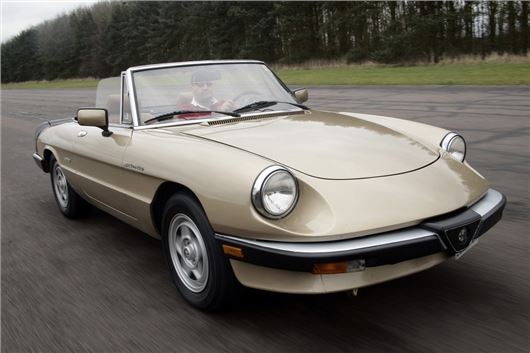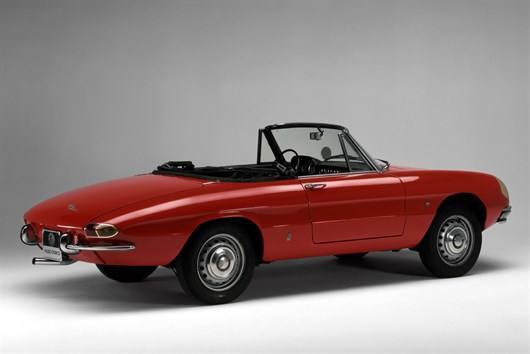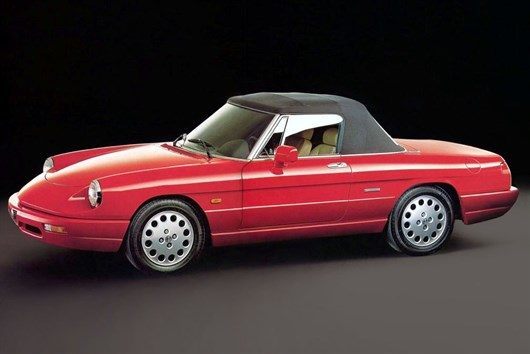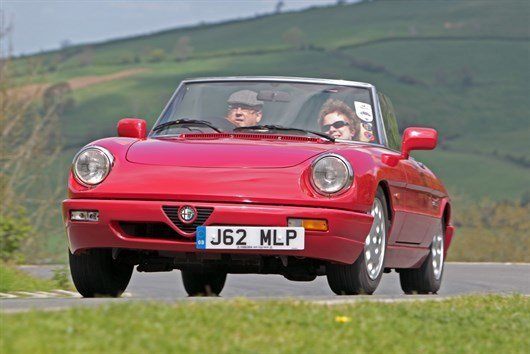Happy Birthday: Alfa Spider

Some things get better with age. Cheese, red wine and car insurance premiums to name but a few. Others things are completely timeless, so we won’t blame you if you fall off your chair when you realise that the Alfa Romeo Spider is 50 years old this month.
Yes, that’s right. One of the sharpest, smoothest and most timeless pieces of automotive design is half a century old. And if that’s not disconcerting enough, next year will mark the 50th anniversary of The Graduate, the movie that made the Spider, not to mention Dustin Hoffman, famous.
So, here’s to you Alfa Romeo Spider. Not only a film star, but the last ever car to have styling input from Signor Battista Pininfarina himself. The founder of Carrozeria Pininfarina died just weeks after the car, known initially as the Alfa Romeo Spider 1600, hit the showrooms, but it was styled by his company, with his direct input. And if he’d have known it would have enjoyed a production run of an astonishing 28 years, we reckon the boss would have been very happy indeed.
Based on the mechanical layout of the Alfa Romeo Giulia 105 Series, the Spider was effectively an amalgam of a number of different Pininfarina design studies from the previous decade. It most closely resembled the Alfa Romeo Spider Super Sport, first shown at the 1959 Geneva Motor Show, which shared much of the front end and boat-tail styling that were to feature on the production car.

To coincide with the Spider’s launch in March 1966, Alfa Romeo ran a competition, offering an example of the new sports car as a prize for the person who came up with the best name. The winner was Italian Alfa fan Giodobaldi Trionfi, who put forward the name Duetto.
Early Spiders are still known by the Duetto name today, yet the model was never officially known by the moniker, as when Alfa tried to register the name, it found it that it had already been licenced elsewhere. Clearly, they made enough noise at the time, as the car is known everywhere other than officially as ‘Duetto’.
It was a Duetto Spider in trademark lipstick red that was the star of the silver screen in the year of its American launch, 1967, with a 30-year old Dustin Hoffman behind the wheel. Hoffman played the role of Benjamin Braddock, who was supposedly 10 years younger than the actor himself. Braddock was famously seduced by the character of Mrs Robinson, played by Anne Bancroft, in a film that pretty much became the world’s first romantic comedy. Needless to say, the Alfa Romeo breaking down became a fundamental part of the plot.
Box office success led to sales achievements despite the car’s misbehaviour in front of the cameras, and the Spider went on to become one of the USA’s most popular European imports, despite costing more than a contemporary Chevrolet Corvette or Ford Mustang, with half the cylinders and a quarter of the engine capacity. Increases in engine size to 1750 and 2000cc helped, but only a little.

It was priced at a similarly exotic level in the UK – for similar money, customers could choose a Jaguar E-Type or Austin-Healey 3000, yet somehow the Spider acquired a niche following, and one that would sustain it for an incredible production run.
The most significant change came in 1970, when the pretty but impractical boat-tail rear end was fattened and flattened. Kamm-tail Spiders, as they became known, were far more practical in terms of usable luggage space, but purists argue that Pininfarina’s delicate lines were somewhat spoiled by the square-edged new look.
Worse was to follow. With the USA being the Spider’s biggest export market, safety regulations in 1974 meant an increased ride height and chunky rubber bumpers were added to the mix, the only saving grace, from Alfa Romeo’s perspective, being that the Spider fared better than the MGB, which was forced to acquire a large polyurethane nosecone.
Further changes came in 1980 – wider bodywork, bigger bumpers and a rubber boot spoiler, along with new rear light clusters, gave the Spider a more modern appearance to take it into its third decade, where it continued to sell steadily to an enthusiast audience. Indeed, in 1986, the model’s 20th birthday, a grand total of 7,215 Spiders were built, almost twice the number sold in 1967, its first full year on sale.

Production of the Spider should have ceased in 1990 with the closure of the production facility at Pininfarina’s Grugliasco base, but instead, a new line was installed at San Giorgio Canavese, near Turin, where a fourth generation of the model would be produced after outcry from enthusiasts that production could be about to cease.
The last incarnation of the Spider again saw some styling modifications – softer, rounder, body-coloured bumpers, a more upmarket cabin and an automatic transmission option were introduced, recognising the car’s appeal now as more of a grand tourer. It still handled well, but other, more modern cars were easily more nimble and it was very much the Spider’s retro appeal that was its main selling point. Indeed, it was a big selling point, as in the model’s 25th year of production, 1991, more Alfa Romeo Spiders were produced (9,073) than in any other year of its history.
It was a combination of safety legislation, emissions control and the emergence of an all-new Spider, based on the same platform and running gear as the Fiat Coupe and Alfa Romeo GTV that finally killed off the classic model. By the time that happened, in 1993, The Graduate’s Benjamin Braddock would have been 48 years old, or roughly the same age as Mrs Robinson was supposed to be when she famously seduced him. Meaning that she’d be about to celebrate her 97th birthday… Doesn’t bear thinking about, does it?
Compare classic car insurance quotes and buy online. A friendly service offering access to a range of policies and benefits.


 Craig Cheetham
Craig Cheetham
 NEC classic motor show 2020 postponed due to Covid 19 concerns
NEC classic motor show 2020 postponed due to Covid 19 concerns
 Classic car auction house Coys goes into administration
Classic car auction house Coys goes into administration
 Motor racing great Sir Stirling Moss dies aged 90
Motor racing great Sir Stirling Moss dies aged 90
 Alfa Romeo anniversary races set for Silverstone
Alfa Romeo anniversary races set for Silverstone
 Government to make E5 fuel available for classic owners
Government to make E5 fuel available for classic owners
 Plans to introduce cleaner fuel could damage more than a million classic cars
Plans to introduce cleaner fuel could damage more than a million classic cars
 Top 10: Classic cars from the Gulf motor racing heritage collection
Top 10: Classic cars from the Gulf motor racing heritage collection


